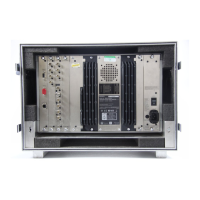
Do you have a question about the Sony Trinitron BVM-A14F5U and is the answer not in the manual?
| Screen Size | 14 inches |
|---|---|
| Aspect Ratio | 4:3 |
| Display Type | CRT |
| Technology | Trinitron |
| Input Connectors | BNC, SDI |
| Scan Modes | 480i, 576i, 480p, 576p, 1080i, 720p |
| Resolution (TVL) | 800 TV lines |
Guidelines for safe operation, inspections, and abnormality handling.
Explanation of safety alert icons.
Rules for internal access, power cords, and water/foreign objects.
Instructions for voltage, environment, high voltage, and grounding.
Cautions for power cords, ventilation, placement, and environment.
Cautions for operation, handling, cleaning, and physical safety.
Procedures for connecting, moving, cleaning, and installing components.
Caution regarding ventilation and clearances in enclosed spaces.
Precautions regarding magnetic fields affecting the monitor.
Considerations for installing the monitor in a rack.
Notes on CRT surface care and cleaning procedures.
Notes on installing the 4:3 mask.
Key features include multiformat, high resolution, network control, memory stick support, auto adjustments, safe area display, expandable inputs, stable color temp, and blue-only mode.
Features related to matrix switching and digital uniformity adjustments.
Includes remote terminal, test signals, H/V delay, degauss, and CRT protection.
Monitor control unit and auto setup probe for advanced operations.
Adapters to expand input connectivity options.
Details on HD SDI/SDI and Analog Component input adapters.
Table showing signal compatibility with different input adapters.
Step-by-step guide for installing input adapters into option slots.
Identifies and describes the function of each control on the front panel.
Controls and indicators for selecting and managing monitors in a network.
Buttons and knobs for manual adjustment of picture parameters.
Buttons used for navigating and operating the menu system.
Status indicator lamps for operation, standby, and overload conditions.
Overview of function buttons for switching operating conditions.
Slots for memory cards and external probes/accessories.
Detailed settings for marker, safe area, safe title, and center marker functions.
Identifies and describes the function of each connector and switch on the rear panel.
Details on LAN and SERVICE connectors for network and maintenance.
Table showing aperture correction frequency for various signal systems.
Explanation of Memory Stick, its types, and general information.
Step-by-step instructions for inserting and ejecting the Memory Stick.
Explains Memory Stick, its types, data speed, and MagicGate technology.
Details on Duo and PRO Duo Memory Stick types and usage.
Precautions and guidelines before using Memory Sticks.
Step-by-step guide for attaching the 4:3 mask.
Instructions for removing the 4:3 mask and reinstalling the 16:9 mask.
Guide to connecting the monitor to a network via Ethernet.
Explanation of monitor ID and group ID for network control.
Details on monitor select buttons and their corresponding lamps for network selection.
Step-by-step guide for establishing remote connections via network settings.
Procedure for setting the region and initial color temperature on first use.
Detailed functions of buttons used for menu navigation and input.
Steps to display menus, select items, and navigate through menu levels.
Explanation of the numbering system used for menu items in the manual.
Procedures for aborting menu operations and handling errors.
Methods for selecting options or values within menu settings.
Procedures for entering numerical values and text data via the keypad.
Guide to entering character names and labels using the keypad.
Method for deleting characters during text input.
Overview, structure, and configuration of the PICTURE ADJ menu.
Guide on how to interpret menu item numbers and descriptions.
Overview of System Configuration, network, parallel remote, power, blanking, display, password, maintenance.
Overview of installation settings like landing, alignment, uniformity.
Overview of data operations: save, copy, delete, maintenance.
Overview of monitor status and information display.
Overview of controller network and system settings.
Overview of key lock settings.
Overview of the picture adjustment menu functions.
Detailed structure and configuration of the PICTURE ADJ menu.
Performs automatic adjustment of chroma, phase, and matrix.
Procedures for changing and resetting matrix data.
Option to select color bar signals for testing.
Adjusts phase, chroma, brightness, and contrast using manual knobs.
Copies picture adjustment data from other sources.
Overview of color temperature adjustment methods.
Details the structure and hierarchy of the COLOR TEMP ADJ menu.
Explains how to read and interpret setting lists within the menu.
Displays and allows selection of preset color temperature data.
Adjusts color temperature using manual knobs.
Details manual adjustment of gain and bias using knobs.
Performs automatic adjustment of color temperature using probes.
Steps for performing automatic color temperature adjustment.
Copies color temperature data from other sources.
Resets color temperature settings to factory defaults.
Analyzes monitor performance using probes.
Sets data for input signals, including format, slot, connector, aspect ratio, scan size, sync, color temp, and picture preset.
Assigns internal signals to specific channels for system switching.
Assigns input connectors and slots to the current channel.
Details settings for channel, format, slot, input number, aspect ratio, scan size, sync mode, color temp, and picture preset.
Details settings for matrix, aperture, YC SEP, NTSC COMB FILTER, marker, mode, H PHASE, channel name, and copy from.
Details settings for picture preset, matrix, aperture, YC SEP, NTSC COMB FILTER, marker, and H PHASE.
Allows selection of signal format for various input types.
Allows selection of Y/C and Component/RGB signal formats.
Settings for matrix selection and marker display modes.
Settings for safe area marker and center marker display.
Settings for safe title display and positioning.
Assigns names to channels for identification.
Settings for network, remote control, power, blanking, display, password, and maintenance.
Assigns names to channels for identification.
Copies channel data from other monitors or memory sticks.
Outlines the hierarchical structure of the System Configuration menu.
Explains setting lists within the System Configuration menu.
Configures network IP address, subnet mask, and default gateway.
Configures parallel remote control functions and pin assignments.
Settings for monitor power-up state and blanking adjustments.
Configures on-screen display of signal format, channel number, and name.
Manages menu passwords, including changing and applying them.
Accesses the maintenance menu for service personnel.
Adjusts geometry, convergence, and CRT color unevenness.
Outlines the hierarchical structure of the Installation Settings menu.
Corrects beam landing shift caused by earth's magnetism.
Adjusts picture position, size, geometry, and convergence.
Corrects pincushion distortion, trapezoid distortion, and convergence.
Adjusts CRT color unevenness using manual or automatic methods.
Details manual gain adjustment for R, G, B, and luminance using knobs.
Automatically adjusts the entire screen using the BKM-14L probe.
Automatically adjusts a single selected point using the BKM-14L probe.
Instructions for manual adjustment, including character erasure and confirmation.
Procedures for performing automatic full-point and one-point adjustments.
Operations for saving, copying, and deleting system data to/from a Memory Stick.
Outlines the hierarchical structure of the File Management menu.
Saves system data to a Memory Stick with file naming.
Copies data from other monitors or Memory Sticks.
Deletes files from the Memory Stick.
Performs backup, restore, and reload of system and factory data.
Views general data about monitor status, current channel, and input adapter.
Outlines the hierarchical structure of the STATUS menu.
Displays information about the used channel and internal signals.
Displays installed adapter types in option slots.
Displays information on the connected controller.
Configures network settings and monitor display methods for the controller.
Outlines the hierarchical structure of the CONTROLLER menu.
Locks buttons and settings to prevent unauthorized changes.
Enables or disables key lock functionality on the monitor.
General system information, CRT type, aperture grille pitch, effective picture size, protection, warm-up time, anode voltage, and chromaticity.
Power specifications and details of input/output connectors.
Environmental conditions for operation, storage, and transport.
List of included accessories like power cord, manual, and masks.
Table listing supported signal systems, frame rates, aspect ratios, and standards.
Table detailing compatibility with various signal formats across different adapters.
Diagrams and pin assignments for special cables connecting probes.
Technical drawings showing the physical dimensions of the monitor.
Diagrams and pin assignments for special cables connecting probes.
Alphabetical index of menu items with page numbers and main menu references.
Diagrams and pin assignments for special cables connecting probes.
Alphabetical index of menu items with page numbers and main menu references.
Alphabetical listing of menu items, their pages, numbers, and main menus.
Alphabetical listing of menu items, their pages, numbers, and main menus.
Critical warnings regarding fire, shock, moisture, and unauthorized access.
Compliance information for US (FCC) and Canadian (ICES-003) regulations.
Details conformity to EMC, Low Voltage Directives, and relevant European standards.

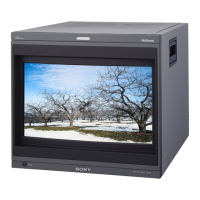






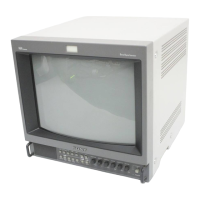

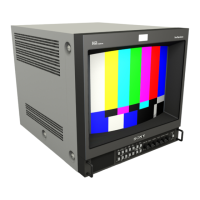
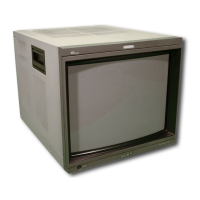
